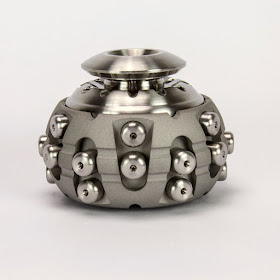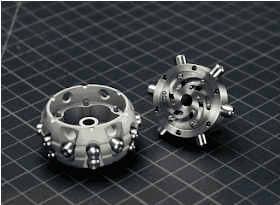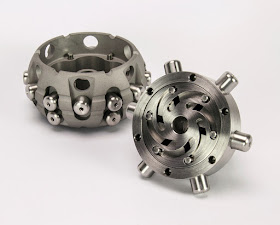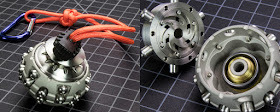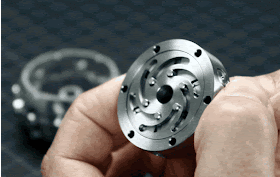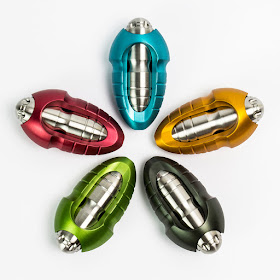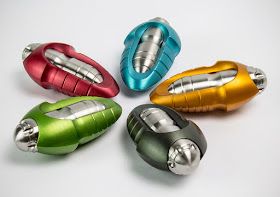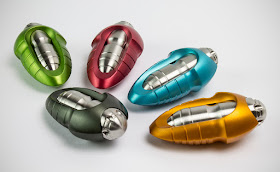Hello again everyone.
I have something really fun to unveil today. I'm calling this new kinetic work
"The Bathgate Ratchet"
This series is another entry in my growing line of mechanical experiments intended to bridge my sculpture practice with the utilitarian trends I am observing in the machinist community at large.
This one borrows from both my slider work, and my Netsuke project. It is a detent driven art piece that incorporates influences from the machined metal lanyard bead community as well.
This work uses a unique ratcheting mechanism. Basically the center sphere has a stepped bearing guide that only allows the ball bearings and springs that are nested inside to ride around the track in a single direction. This has the effect of revolving the inner geometry in steps when you sort of move the outer parts in a butterfly motion. It is similar to how a socket wrench works.
The design also has a hole running through the length of the work to enable it to potentially be strung on a lanyard or worn however one might like. However, like the Netsuke project, this is a bit large for an actual bead so that design choice is there as both an homage and a challenge.
While the design of the sculpture took on many forms during its development, I was ultimately able to come up with something that required zero compromise as far as how I wanted the final artwork to look. Even if this work was non mechanical, I feel quite confident I would have designed a stand alone sculpture that looks just like this.
The sculpture functions perfectly as a static art object, while also performing its intentionally trivial, yet entertaining, function.
The mechanism was initially inspired when I handed a version of the S2 Slider to a friend of mine and they mistakenly twisted the work rather than sliding it open. Not what you are supposed to do with an S2, but I thought it was a great idea so I immediately got to work sketching something that could operate in a twisting fashion. Eleven months later and here we are.
The mechanism worked surprisingly well on the very first prototype and makes a great clicking noise that is sure to delight (and annoy others) in equal amounts.
I have settled on four colors, Deep copper Orange, Charcoal Black, Deep Cyan Blue, and the very much requested as of late, purple violet.
While I could have chosen any number of colors for the anodizing, I think a limited palette is preferable. These are the colors I feel work best for this geometry, so lets save some of the others for the future.
But just because I am limiting colors, it does not mean that I am not open to the idea of doing a two tone combo though!
So as with my other editions, a limited run of these works will be on offer. Because previous projects have been so popular, I am really going to push myself hard to make a larger quantity of these available (though it may kill me...just kidding I'll be fine).
Currently, I plan to make 99 of theses works. I am leaving the door open to add a few additional units if demand gets too out of hand (as frequently happens). So I am reserving the right to add extra units that I will distribute in as fare a way as possible if I see it fitting to do so.
I'd like to leave the sign-up open for a few days (instead of a few minutes) so everyone has a chance to add their name, so if the first 99 units sell out quickly, I will likely add just a few more that I will assign randomly to a some lucky people on the remaining wait list.
So lets set a date for the sign-up sale then.. if you are interested in adding one of these works to your collection....
The pre-order will open this coming Thursday (Nov 2nd) at 4PM (EST). I will send out the link via my email newsletter (mailchimp). I will also link it on my various social media, but the email will go out first for those of you trying to get in early.
The link will go to a google form where you can fill out your contact info and allow you to specify your preference for color. The form will also detail the pricing, shipping, and how payments will be processed. I do not post pricing on publicly facing media so you will have to wait until the link goes up to see the price. (Think more than an S2 and less than the NHVB for those who are familiar)
The first 99 people to sign up will be guaranteed one of the works. Everyone who signs up after the 99 limit is reached will go on to a waiting list.
Any additional units I decide to make, as well as any cancelations will be assigned to the remaining names on the list via random name drawing. I am limiting everyone to just one work as I want to get these into as many different hands as possible.
Do not sign up more than once or I may disqualify you.
If you are not on my mailing list, please sign up here before Thursday morning and white-list the following email address in your mail client to ensure you receive the email: "chris@chrisbathgate.com"
So again, keep an eye out for the Thursday pre-order email. And if you are reading this at some distant point in the future, I am sorry, but the moment has passed.
As always, comments and questions are welcome and thank you again for all of your enthusiastic support.
































